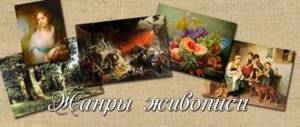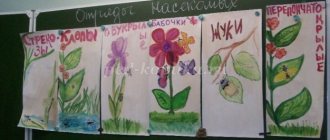Presentation on the topic “Types of fine arts”
Presentation on the topic “Types of fine arts” on fine arts in powerpoint format. This presentation for schoolchildren talks about such types of fine arts as painting, sculpture, and architecture. The presentation contains a large number of illustrations. Author of the presentation: Tatyana Nikolaevna Sergeeva, art teacher.
Fragments from the presentation
Painting
- a type of fine art whose works are created using paints applied to any surface. Painting is an important means of artistic reflection and interpretation of reality, influencing the thoughts and feelings of viewers.
- The main technical varieties are oil painting, painting with water paints on plaster - wet (fresco) and dry (a secco), tempera, glue painting, wax painting, enamel, ceramic painting, silicate, synthetic paints, mosaic, stained glass; watercolor, gouache, pastel.
Portrait
(French portrait), an image of a person or group of people; in fine art, one of the genres in which human individuality is recreated.
Scenery
(French pays), view, image of some area; in painting and graphics, a genre in which the main subject of the image is nature. Often depicted are views of cities or architectural complexes (architectural landscape, veduta), sea views (marina).
Still life
(French nature morte, lit. - dead nature), a genre of fine art (mainly easel painting), dedicated to the depiction of inanimate objects (utensils, fruits, game, bouquets of flowers, attributes of any activity, etc.).
Sculpture
- (from Latin sculpo - carve), a type of fine art, the works of which have a three-dimensional, three-dimensional shape and are made of solid or plastic materials. The sculpture depicts mainly humans, less often animals.
- The artistic means of sculpture are the construction of a three-dimensional form, plastic modeling (sculpting), development of silhouette, texture, and in some cases also color. A distinction is made between a round sculpture (statue, group, figurine, bust), viewed from different sides, and a relief (the image is located on the background plane).
Architecture
- (from the Greek architekthon - builder), the art of designing and constructing buildings and other structures that create the environment necessary for people to live and work, in accordance with the purpose of society..
- Expressive means of architecture - composition, tectonics, scale, proportions, rhythm, plasticity of volumes, texture and color of materials. In architecture, functional, technical, and aesthetic principles (usefulness, strength, beauty) are interconnected.
Graphic arts
- from (grapho - I write), a type of fine art that includes drawing and printed artistic images (engraving, lithography, etc.), based on the art of drawing and made with pencil, pen or charcoal.
- Expressive means of graphics - a contour line, a stroke, a spot (sometimes a color), the background of a sheet with which the image forms a contrast or nuanced relationship.
Art in space
What does art mean in space? Objects of spatial art are stored and delight us constantly. These are paintings, sculptures, design solutions, wood painting, origami. That is, this is all something that we can consider as much as we like.
For example, while walking through the park, we saw a monument that caught our attention. We can get closer. You can sometimes touch a spatial image, feel its texture, etc.
Main types of art in space
In this category, it is customary to distinguish the following types or subtypes of art:
Painting
One of the most ancient forms of art. Painting takes its origins from time immemorial, from rock paintings in the caves of primitive people. Through painting, artists convey the life, character, customs of their contemporaries, even their character.
Looking at the paintings of great master artists, you involuntarily ask yourself a question? What kind of talent do you have to have to convey reality and feelings so accurately?
Painting, in turn, is divided into genres:
- Portrait
- Still life
- Scenery
- Historical genre, etc.
With the advent of cameras, painting did not recede into the background; on the contrary, it developed. The fact is that in Art it is not so much the result itself that is important, but the process of creativity. Only when the creator puts his creation through diligence, and sometimes even many years of work, do masterpieces emerge.
Photography is also becoming one of the art forms - the process of filming, working with lighting and decorations is undoubtedly painstaking work, and many photographs undoubtedly delight and excite the imagination.
Architecture
Architects are working on large-scale buildings. They build skyscrapers, bridges, churches, cathedrals, fountains. An architect must have special knowledge and skills. As a rule, a whole team works on the creation of architectural structures, involving specialists from various fields and art historians. It may take more than a dozen years to bring a grandiose project to life.
Depending on the location and period of the building, architecture varies in style. Knowing the historical features, art historians can immediately determine in what period a particular building or structure was erected.
There are countless architectural styles; they are divided into types and subtypes; we list the most common:
- Ancient Egyptian style
- Ancient styles (ancient Greek, ancient Roman, Byzantine)
- Roman style
- Gothic style
- Renaissance or Renaissance styles
- Baroque
- Rococo
- Modern
- High tech
Design art
Nowadays the profession of designer is very popular. We all love to experience beauty. It’s nice to walk along beautiful, well-kept streets and visit cozy establishments. People like the bold decisions that designers make.
The designer’s task is not only to make the space around us beautiful, but also to combine this with practicality and ease of use. Design also includes the decoration of objects - vehicles, books, buildings, interior items, as well as the design of Internet resources.
Design is divided into types or genres, because it covers almost all areas of our lives:
- Web design
- Graphic design
- Landscape design
- Sound design
- Book design
- Industrial Design
- Lighting design
- Fashion design, etc.
Arts and crafts
Knitting, embroidery, macrame, origami, beading are types of arts and crafts. As a rule, people make these types of creativity their hobbies and interests. But very often, thanks to this passion, real masterpieces are born!
MAGAZINE Preschooler.RF
Introducing preschoolers to art. Topic: “Introduction to portrait painting” (preparatory group) Objectives: · Continue to teach children to distinguish between genres of painting; · Expand your understanding of portraiture: portrait of a child and an adult; · To strengthen children’s ability to draw a portrait of a person, conveying the characteristic features of his face and mood; · Develop aesthetic perception; · To instill in children a sense of beauty. Materials: Reproductions of paintings by Russian artists (according to the program), sheets for watercolors, oil pencils, mirrors, napkins, D/I “Post a Portrait”. Move N.O.D. Educator: Children, today they brought a letter to our kindergarten. Are you interested in knowing what it says? (Read the address of the kindergarten). Letter: “Hello guys!” I want to ask you for help. I am organizing an exhibition of paintings of different genres, and I miss paintings in the portrait genre. Please help me arrange the exhibition, draw portraits. But in order for your drawings to be included in the painting exhibition, you need to: 1. Answer the quiz questions. 2. Visit the mini-museum of Russian artists. 3. Collect portraits. 4. Draw a portrait of a person, expressing his emotions. Thank you! Sincerely, artist Kraskin. Educator: Well, are you guys ready to help the artist Kraskin? Educator: Artist Kraskin sent us a quiz that we need to answer. (Presentation on genres of painting). Sit down on the chairs and get ready to answer questions. (Children sit on chairs and answer quiz questions.) Educator: Well done! You know a lot about artistic creativity. And now, in order for us to go further to the art studio, we need to visit the mini-museum of Russian artists. But, before visiting the museum, let's remember the rules of behavior in museums. (Children are told the rules of behavior in the museum). The teacher invites the children to put on virtual slippers and go on an excursion to the mini-museum. (The teacher puts on a “tour guide” badge.) Suitable for reproductions of Russian artists. Educator: Children, look at the pictures. Who can show paintings painted in the portrait genre? Children's answers. The teacher offers to look and compare portraits: children and adults. Reproductions of paintings: A. Venetsianov. "Zakharka"; V. Tropinin. "Portrait of a Son"; I. Repin “Girl with a bouquet”, etc. (children). Adults: O. Kiprensky “Portrait of A.S. Pushkin”; K. Bryullov “Self-portrait”, etc. Children compare portraits: “Zakharka” by A. Venetsianov and “Portrait of A.S. Pushkin" by O. Kiprensky. Children are asked leading questions: What is the name of the picture in which the person is depicted? (Portrait). Who do you see in the portraits? (Adults and children). How did you guess that these are children and these are adults? (By age, by face, etc.) Is it possible to tell what mood the artist painted? (Sadness, joy, sadness, fun, etc.). The teacher sums up the conversations - We looked at various portraits, these were adults and children. The artist also captures in his paintings: children, men and women. Artists, when drawing a person, convey not only his appearance, but his mood. Artists put their whole soul into the painting they paint. This is a lot of work!Educator: Did you like the mini-museum? Now we need to move on and complete the following task: D/I “Post a portrait.” Children are divided into groups (choosing chips by color). In front of them are envelopes (according to the color of the chip): in the envelope is a cut portrait of a person into 5-6 parts. Each portrait has its own emotion: sadness, joy, calm, fear, surprise, etc. (I had 12 children - 6 envelopes). Children collect a portrait of a person and describe his mood (emotion).
Educator: Well done! So we got to the Art Studio. We take our places. The children are seated at the tables. Before we get to work (drawing portraits), let's do a little finger exercises: children take simple pencils, place them between their palms and begin to roll the pencil between their palms, when the palms are warm, you can start working (put the palms to the face - to the cheeks). They also take mirrors and examine their face, remembering parts of the face: eyes, nose, eyebrows, eyelashes, mouth, ears, iris (it comes in different colors: green, blue, brown, etc.). The children get to work, drawing portraits. Be sure to include calm music (I included Chopin’s “April” performed by a symphony orchestra).
Design of an exhibition of children's works. Discussion of painted portraits. At the end of the lesson, the teacher takes out an envelope and tells the children that after their parents visit and look at their painted portraits, we will send these portraits to the artist Kraskin. At the end of the lesson, you can invite parents to an exhibition of children's drawings.
| Next > |






